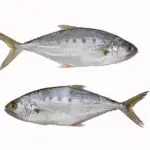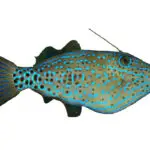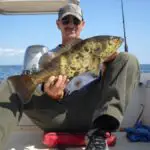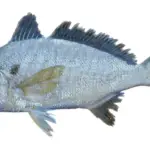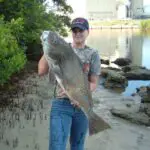Snook are one of the most popular species of inshore fish in the world of saltwater fishing.
They grow big, fight hard, jump, and more…but are snook dangerous?
If you are new to snook fishing, this is a completely valid question. They are quite the intimidating fish!
Table of Contents
- Are Snook Dangerous?
- How To Handle a Snook
- How To Safely Unhook and Release a Snook
- Final Thoughts
- Related Posts
Are Snook Dangerous?
Snook are large predatory fish that look intimidating, but they are not dangerous to people. Most injuries occur when snook are not handled properly, resulting in a cut or abrasion from their gill plate or fins.

Snook pose no threat to humans in terms of diving, snorkeling or being in their presence.
I’m not aware of any instances where a snook has attacked a person. In fact, most people are excited when they spot a snook on the boat or in the water!
Can Snook Hurt You?
While snook aren’t dangerous, they can hurt you if you hold them incorrectly.
Like many other perch-like fish (Perciformes), snook have sharp spines along their dorsal and anal fins. If you aren’t careful, their spines could pierce your skin and cause a lot of pain.
The gill plates on snook are also very sharp!
Their gill plates have razor-sharp scales, so if you try to gill a snook, your hand could get cut up really bad.
I’ve seen it happen before, so don’t hold snooks by their gill plates…not to mention it can seriously harm the fish!
Fortunately, just like bass, snook don’t have sharp teeth, so you can lip them safely.
Do Snook Bite People?
Unless you’re hand-feeding pet snook at a dock or tourist attraction, snook do not bite people.
Some marinas have pet snook and tarpon, and they feed them regularly. You can visit these marinas and hand feed the snook and tarpon yourself. Be ready though, because snook and tarpon have a powerful bite.
While releasing a snook, they might bite onto your fingers lightly. This is just their way of holding onto you while they recover their energy before swimming off.
Do Snook Have Sharp Teeth?
Snook don’t have sharp teeth, so you can safely lip them. However, even without sharp teeth, snook can still fray through your fishing line.
Snook lips are thick with a sort of rough sandpaper feel, just like largemouth bass.
Don’t worry, snook do not have rows of large and intimidating teeth like a barracuda or a shark.
If you handle a lot of snook, you may get a case of ‘bass thumb’, which is just the roughing of the skin where you lipped the fish. I see it as a sign of success!
Can Snook Cut You?
Yes, snook can cut you if you handle them incorrectly. The gill plates on snook, especially the smaller ones, can easily cut your skin.
The gill plate is a hard bone-like feature that protects the snook gills, and it can cut you if you are not careful.

I’ve been cut several times by smaller 15-inch snook. Usually, it’s just like a paper cut.
Can You Thumb a Snook?
Yes you can thumb a snook, just like a bass. Lipping snook is a great way to safely handle them. It’s safe for you and for the fish. Just be sure to support the belly in a horizontal position on larger fish.
Related: Are Sheepshead Fish Dangerous? Here’s What You Should Know
Are Snook Poisonous?
Snook are not poisonous. They are perfectly edible, and safe to eat.
In the past, snook had bad reputation because they used to be known as ‘soap fish.’
They gained this name for the soapy flavor they were said to have when prepared with the skin on.
People thought they tasted bad until they started preparing them with the skin off.
Wow, times sure have changed because nowadays most people consider snook to be one of the best-eating fish in the ocean!
How To Handle a Snook
You can lip snook, just like a bass. For large fish, especially those over 26 inches, you should also support their body using a second hand. Don’t hold these large fish vertically, because their weight can crush their internal organs.
If possible, use a large landing net to land a snook. Not only is it safer for the fish, but safer for the angler too.
Keep the snook in the net, in the water. If you wish to take a photo, do it quickly and return the snook back to the water as soon as possible.

When fishing on rocks and reefs, avoid letting the fish lay on the rocks. This can damage their scales, scrape up their body, and cause other external damage.
(Be especially careful if you are snook fishing at night, oftentimes the fish flop and get really banged up on the rocks!)
Measuring snook should be a quick and streamlined process. Having a measuring board ready go to makes catch and release much easier!
How To Safely Unhook and Release a Snook
Unhooking and releasing a snook is the same process as any other fish.
If the hook is easy to reach you can just use your fingers to gently pop the hook out.
If the hook is deeper or you’re using a treble hook lure, you should use forceps or pliers to reach the hook and gently unhook it. Be careful not to rip their mouth or damage their gills or eyes. Return the snook to the water quickly. You may need to hold the snook in the water for some time until it recovers its energy and swims off.
Point the head of the snook into the current and gently hold it until its ready to kick off and swim away.
If you’re fishing off a high pier or bridge, you’ll need to use a pier/bridge net.
Put the snook in the net and lower it down in the water. Hold the net in the water until the snook swims out.
Final Thoughts
In Florida where I live, snook are plentiful. They’re extremely popular to catch, and I’ve caught my fair share over the years.
Snook are not dangerous, and humans have no reason to fear them.
Treat each snook you catch or encounter with respect, handle them with care (if fishing catch and release) and the risk of injury is practically zero.
Most of all, have fun!
You May Also Like: Are Jack Crevalle Dangerous? Here’s What You Should Know

Growing up in Florida, I’ve been surrounded by saltwater my entire life…and I love sharing my passion with others.
To learn more about why I started Saltwater Mecca, visit the ABOUT page.
Thank you for reading this article. Browse around & have some fun!

